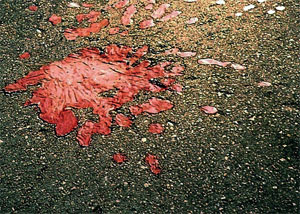 I recently became aware of the Sarajevo Roses: Deep scars in the concrete of Sarajevo created by the thousands of mortar rounds fired there during the intense urban warfare of the Bosnian War. Where these explosions resulted in casualties, the scars have been filled with a red resin.
I recently became aware of the Sarajevo Roses: Deep scars in the concrete of Sarajevo created by the thousands of mortar rounds fired there during the intense urban warfare of the Bosnian War. Where these explosions resulted in casualties, the scars have been filled with a red resin.
I was touched by the sad, serene beauty of these enduring monuments.
But since I’m the creator of fantasy worlds, my mind was also inspired. Taking the familiar and twisting it to the fantastic is nice. Taking something culturally unfamiliar and then, on top of that, giving it an extra twist of fantasy can often result in some really memorable touchstones.
The Sarajevo Roses exist as both an artifact and a memorial of a specific, historic event. More importantly they’re an unintended side effect that, to my American eyes, testifies that something outside of my normal experience happened in this place. What sort of fantastical equivalents could we hypothesize?
Direct fantasy parallels, for example, aren’t too hard to conjure up: The long, blackened scars in the fields around a village where the blight-breath of an elder dragon prevent anything from growing. The effervescent green sands driven into the eastern walls of an adobe village by the sandstorm thrust up by the execution of the Seven Gods. And so forth.
Going a bit further afield, what examples of fantastical side-effects could we postulate from non-destructive events? Are there oil slicks in the street from the fad for armor golems among the city’s mages? Are the skies above the city filled with long twists of multi-colored thread because magic carpets have a tendency to unravel? (And once a year is there a Skein Day when the magical thread is gathered for some purpose either practical or festive?) Does the casting of a time stop spell leave little temporal schisms?













I think the fact that it’s a memorial is a big part of the somberness of it. That there were people paying attention and keeping track enough that something like the red resin could be applied.
Picture the village of Ahmiran. As the PCs approach, they see swords and spears stuck into the earth. Some are rusted, barely recognizable for what they were, while others are fresh. In spots, they appear in clusters. Where the weapons are newest, they are planted in the midst of half-buried bones.
“Gravestones,” is the answer, should they ask a villager. Each marks where a villager died, fighting the orcs who raid once every season except winter. The first swords were planted that way when a villager died on the outskirts of the town, and his comrades were in no position to return him home or to bury him. It eventually became a reverent way of marking those dead in the defense of Ahmiran – one that the orcs, strangely, haven’t interfered with.